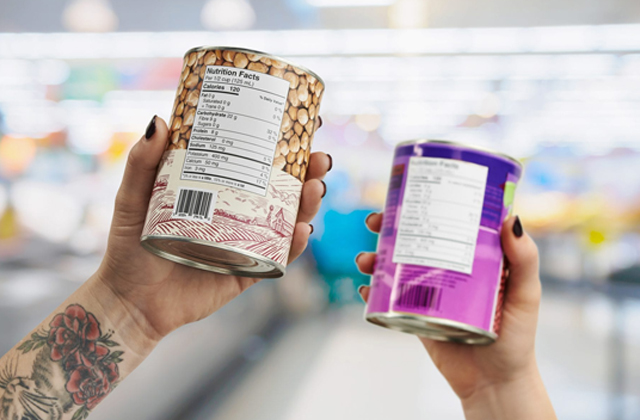For A Healthy Eating Lifestyle, Learn How To Read Food Labels
The common eye tends to focus on the calorie count when reading food labels. Although calories should be taken into account when trying to Lose Weight, they do not represent the entirety of a meal. We can make better choices if we know the ingredients in the meals and beverages we eat. It enables us to determine whether the food we are ingesting is healthy or not. Viewing labels can be challenging because they are not always simple to understand. But, a few basic steps can make your life easier.

Reasons to read food labels
Here are the following reasons why it is necessary to check the food labels.
- Allergies – If a person consumes a substance to which they are hypersensitive or allergic, they may have uncomfortable or even harmful side effects.
- Diabetes - People with certain medical disorders, such as diabetes, must be aware of the precise nutritional value of particular food ingredients.
- Fats – You can identify foods that include trans fats by carefully reading the labels on your food.
You can accomplish balanced nutrition that goes well beyond calorie consumption by heeding the food tag advice that follows:
1. Be cautious about Food Marketing Strategies:
When it comes to whole-food nutrition, phrases like “natural, whole grain, nutritious, created from fruit, 100% daily serving of Vitamin C” are essentially meaningless. Natural is an unregulated phrase in the food market, meaning it can be applied to anything despite it involves high-fructose corn syrup, artificial colors, or excessive sugar levels.
Whole grain denotes that the product comprises a whole grain unless otherwise stated. Check the components list before purchasing a whole-grain product because there is frequently still a lot of sugar present. You’re much better off consuming a complete slice of fruit that is high in fiber and devoid of additives. Most goods that are “made with natural fruit” are mostly made of refined sugar. Instead, choose these apple nachos or a slice of cinnamon-flavored apple.
2. Verify the Serving Size
Check the portion size of any food you choose before purchasing it. Despite a chocolate bar’s claim that each dish contains 10 grams of sugar, a serving may only consist of 4 of the bar’s 16 chocolate pieces. The chocolate bar would have 40 grams of sugar if you were to consume it in one sitting.
3. Check the total Calorie Amount
Calorie counting is significant once you’ve adopted a Clean Eating lifestyle. However, it’s essential to consider the calories in packaged meals if we research them at the groceries store or elsewhere. It will help you understand how much or fewer nutrients you’ll be getting from your calorie consumption. The main focus of clean eating is eating a diet rich in nutrients to make you feel nourished and reduce cravings. We will experience a brief surge in blood sugar after consuming packaged meals heavy in sugar but poor in nutrients, followed by a crash that makes us hungry once more. In these situations, we may have inadvertently ingested half or more of our daily calorie allowance without receiving the good fats, proteins, and nutrients that our bodies require to activate the “I’m full” signal in the brain and enable us to move on with our days.
4. Check and Confirm Expiration Dates
Beyond the meal’s nutritional value, healthy eating also emphasizes food safety. By using the “sell by,” “use by,” and “best if used by” dates listed on the packaging, consumers can lower their risk of food illness while encouraging the best food quality. However, as a general guideline, the sooner the expiration date, the fresher the product and what is thought to be the most healthy (think dairy products, meats, fruits, and vegetables).
5. Check Additives & Food Colorings
Food colorings have been shown to provide possible health hazards in studies, particularly Red Dye 40, which may be connected to behavioral problems and hyperactivity in young children. According to the Department of Health and Human Services, red Dye 40 causes immune system malignancies in mice and is “reasonably predicted” to be a human carcinogen. There are other food additives in packaged goods with comparable anecdotes. However, don’t let this information stop you from committing to Clean Eating. Knowing more will empower you to make wiser decisions since knowledge is power.
6. Harmful fats and oils
All diseases’ core cause is inflammation, exacerbated by trans fats and highly processed oils. They also lower your good cholesterol. Monounsaturated and polyunsaturated fats aren’t bad for you but stay away from partially hydrogenated and saturated fats because they’re bad for your health. Here are the various forms of oils:
List of following vegetable oils that have been hydrogenated or partially hydrogenated
- Margarine
- Shortening
- Palm oil
- Canola oil
- Kernel oil
Undoubtedly, not all fats are harmful. Avocado oil, olive oil, coconut oil, and ghee are among the goods that provide healthier substitutes for processed oils.
7. Check the sodium:
However, some products, mainly those imported, may occasionally be listed as “sodium.” Adults shouldn’t eat more significantly than 6g of salt per day. (about one teaspoon) daily, which is the maximum daily. The further you go from this top limit—a cap rather than a goal to aim for—the better. The measurements for salt on every packaging are in grams. The substance sodium chloride makes up salt. Sometimes, salt content on food labels is only given in mg rather than g.
- High is color-coded red, which contains more than 1.5g salt per 100g.
- Medium is color-coded amber, ranging from 0.3g to 1.5g per 100g.
- Low is color-coded green, defined as 0.3g of salt per 100g or below.
Check the quantity of sodium in milligrams per serving in each product. For best health, keep your daily sodium intake to no more than the amount of kcal in each serving.
8. Check the Sugars and Sweeteners
The “of which sugars” portion of your food’s label can be used to analyze sugar content; however, sweeteners cannot. Since they often don’t contain energy, they will just be listed in the ingredients. While sweeteners can be a valuable alternative to sugar in calorie-controlled diets or for people with diabetes trying to balance their blood sugar, they can deliver up to 1000 times the sweetness that the taste buds can perceive, which can prolong or even intensify dependence on that sweet flavor. When consumed in large quantities, sweeteners frequently have laxative effects because the digestive system cannot break them down. The majority of sugar-free goods will disclose this information on their packaging.
Final Thoughts
Avoiding all processed foods is the ultimate approach to prevent being duped by product labels. After all, a list of components is not necessary for whole foods. Even so, if you purchase packaged meals, use the helpful advice in this article to separate the inferior goods from the better options.
Oliver Goodwin
Oliver Goodwin is Seattle-based enthusiastic tech researcher. His passion for new and latest technologies makes him different from his peers. He is proficient in writing on a vast range of topics with extremely well-researched and well-structured data. . His presentation skills and convincing power helps him win the trust of his clients. Apart from the technical side, he loves to travel and get exposure to amazing cultures and traditions.
